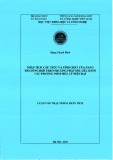
JST: Engineering and Technology for Sustainable Development
Volume 35, Issue 2, April 2025, 001-008
1
A Comparative Study on the Structure and Photoactivity of Titanium Dioxide
Obtained from Various Synthetics for the Degradation of Organic Dye
Nguyen Quynh Vi, Dinh Ngoc Duong, Nguyen Thanh Hung, Truong Minh Thu,
Le Minh Thang, Nguyen Ngoc Mai*
Hanoi University of Science and Technology, Ha Noi, Vietnam
*Corresponding author email: mai.nguyenngoc@hust.edu.vn
Abstract
Titanium dioxide (TiO2) particles were synthesized by the sol-gel method (SG) and sol-gel low-temperature
method (SG-L), utilizing titanium isopropoxide as the precursor. Subsequently, the particles underwent heat
treatment with sodium hydroxide 10M, resulting in samples denoted as SG-H and SG-L-H samples,
respectively. The purpose of this study is to compare these synthesis methods in terms of the stability and
photocatalytic activity of TiO2 catalysts. To determine the optimal synthesis method for generating highly active
TiO2, the obtained catalyst samples were characterized by a variety of techniques, including thermogravimetric
analysis (TGA), differential scanning calorimetry (DSC), X-ray diffraction (XRD), Brunauer-Emmett-Teller
(BET), and UV-vis spectroscopy measurements. The results demonstrated that the structure and phase of
catalysts depend on the synthesis conditions. The surface area measurements indicated values of 0.95, 18.95,
82.65, and 168.59 m2/g for SG, SG-H, SG-L, and SG-L-H, respectively. Furthermore, the degradation
efficiency of methylene blue under xenon lamp illumination was recorded at 87%, 91%, 97%, and 94% after
150 minutes, according to a pseudo-first-order reaction. These results suggest that the sol-gel
low-temperature method is particularly effective in producing high purity, large specific surface area, and good
decomposition of organic dye.
Keywords: Hydrothermal, sol-gel, sol-gel low-temperature, TiO2 particles.
1. Introduction
1
Titanium dioxide (TiO2) is one of the most
significant nanomaterials that has received a lot of
interest because of its wide applications. In particular,
TiO2 has demonstrated tremendous potential in
photocatalysts because of its chemical stability and
lack of toxicity [1]. TiO2 has three phases including
brookite, anatase, and rutile. The anatase phase has the
ability to decolorize faster than the other phases [2].
Therefore, many researchers focus on the synthesis of
high-purity anatase TiO2 catalysts.
There are many methods to synthesize anatase
TiO2 catalyst materials, such as the sol-gel method,
hydrothermal method, precipitation method, etc. The
process of synthesizing nanomaterials by the sol-gel
method includes four steps: hydrolysis,
polycondensation, drying, and thermal decomposition
[3]. This is a common method for the synthesis of
metallic oxides and mixtures of metallic oxides.
Although the obtained material has high homogeneity
and purity, its bond formation and wear resistance are
not good [4]. Another method is hydrothermal, which
has been illustrated to be very efficient and convenient
for the preparation of TiO2 and exhibits good catalytic
activity for dye degradation [5]. In comparison to the
ISSN 2734-9381
https://doi.org/10.51316/jst.181.etsd.2025.35.2.1
Received: Aug 28, 2024; revised: Dec 9, 2024
accepted: Dec 10, 2024
sol-gel method, the hydrothermal method-generated
photocatalyst has a higher crystallinity, greater surface
area, and stronger absorption [5]. However, the
hydrothermal method uses chemicals at high
concentrations and high temperatures for a long time,
which is expensive for materials and harmful to the
environment. Thus, there are some restrictions on
traditional synthesis. Therefore, a number of studies
have been conducted to investigate the optimal TiO2
synthesis conditions that can achieve the highest
degradation efficiency [1]. However, there is a lack of
studies comparing the effects of synthesis conditions
on the TiO2 phase and its activity.
This work presents the synthesis and
characterization of TiO2 nanoparticles prepared by the
sol-gel method (SG) and sol-gel low-temperature
(SG-L) from titanium isopropoxide (TTIP) precursor.
In addition, SG and SG-L samples were further treated
using the hydrothermal method to evaluate their
stability. The aim of our research is to compare the
structure and photoactivity of TiO2 particles obtained
from these methods for the degradation of organic dye
using methylene blue (MB) as a target pollutant. The
crystallinity and phase identification were examined
by X-ray diffraction (XRD). The scanning electron

























